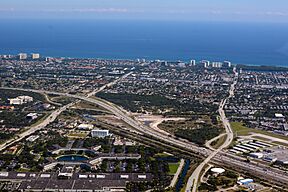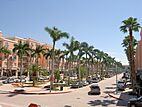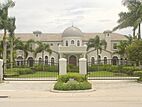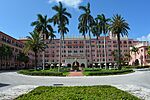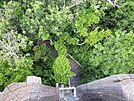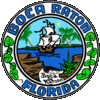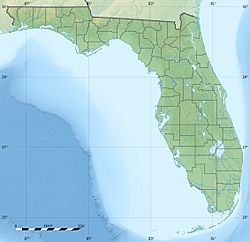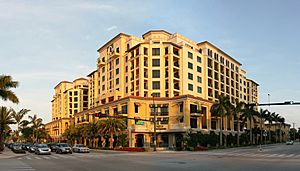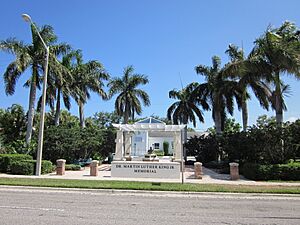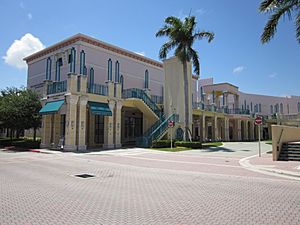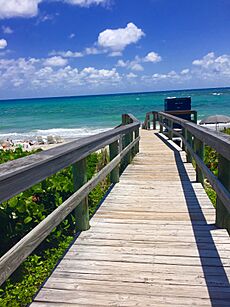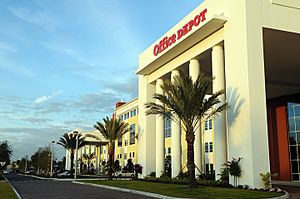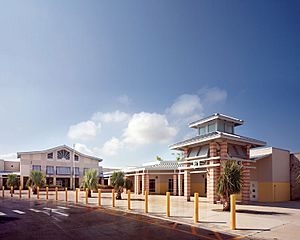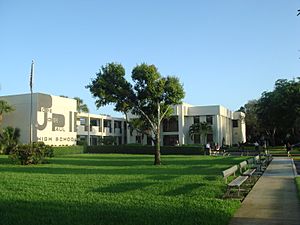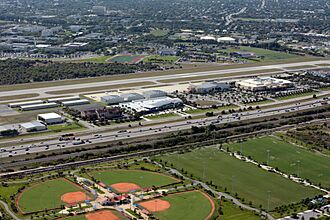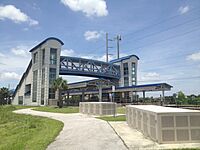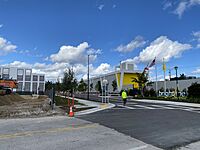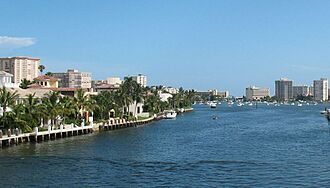Boca Raton, Florida facts for kids
Quick facts for kids
Boca Raton, Florida
|
|||
|---|---|---|---|
| City of Boca Raton | |||
|
East Boca Raton skyline
Mizner Park
Baldwin House at Florida Atlantic University
Boca Raton Resort
|
|||
|
|||
| Motto(s):
A City for All Seasons
|
|||
| Country | |||
| State | |||
| County | |||
| Settled (Boca Raton Settlement) | c. 1895 | ||
| Incorporated | May 26, 1925 | ||
| Government | |||
| • Type | Council-Manager | ||
| Area | |||
| • Total | 31.59 sq mi (81.81 km2) | ||
| • Land | 29.18 sq mi (75.57 km2) | ||
| • Water | 2.41 sq mi (6.23 km2) | ||
| Elevation | 13 ft (4 m) | ||
| Population
(2020)
|
|||
| • Total | 97,422 | ||
| • Estimate
(2022)
|
99,009 | ||
| • Rank | 23rd in Florida | ||
| Time zone | UTC−5 (EST) | ||
| • Summer (DST) | UTC−4 (EDT) | ||
| ZIP Codes |
16 total ZIP Codes:
33427–33429, 33431–33434, 33464, 33481, 33486–33488, 33496–33499
|
||
| Area code(s) | 561 | ||
| FIPS code | 12-07300 | ||
| GNIS feature ID | 0279123 | ||
Boca Raton is a city in Palm Beach County, Florida, United States. It's pronounced like BOH-kə rə-TOHN. In 2020, about 97,422 people lived there. This made it the 23rd largest city in Florida in 2022. Many people with a Boca Raton address actually live just outside the city limits.
Boca Raton is about 45 miles (72 km) north of Miami. It's a main city in the Miami metropolitan area. This big area had over 6 million people in 2020.
The city was first officially formed in 1924 as "Bocaratone." It became "Boca Raton" in 1925. Long ago, the Glades culture Native Americans lived here. Later, Spanish and British people came. The city you see today was mostly planned by Addison Mizner in the 1920s. He helped design many buildings in a special Mediterranean Revival style.
Boca Raton also played a big part in the early computer world. It's where IBM created its first personal computer. Today, Boca Raton is known for its fancy beach culture. It has many malls and shopping centers, like the Town Center at Boca Raton. Big companies like The ODP Corporation (which owns Office Depot) have their main offices here. You can also find the main campus of Florida Atlantic University and the Evert Tennis Academy, started by tennis star Chris Evert. The city has strict rules about building sizes and signs. This means you won't see many big billboards. It also helps keep more green spaces along the roads.
Contents
What's in a Name?
Where Did the Name Come From?
The name Boca Ratón means "Mouse Mouth" in Spanish. On old European maps, this area was called "Boca de Ratones," or "Mouth of Mice."
The word Boca means "mouth." Sailors often used it to describe an inlet or a river mouth on maps. The meaning of ratones for this area is a bit of a mystery. Some people think it referred to "rugged rocks or stony ground" at the bottom of ports. These rocks could rub against ship cables. So, "Rugged Inlet" might be one meaning. Others believe ratones meant pirates who hid in the area. In that case, the name could mean "Pirates' Inlet."
How Do You Say It?
Most people who live in Boca Raton say "Raton" like rə-TOHN. People who are not from the area sometimes say rə-TON instead.
A Look Back in Time
Boca Raton's Story in Short
- 1890: The area called Bocaratone was settled.
- 1896: The Florida East Coast Railway started running trains.
- 1909: Bocaratone became part of the new Palm Beach County.
- 1912: The Intracoastal Waterway opened.
- 1924: The town of "Boca Ratone" was officially formed. Addison Mizner was chosen to plan the town.
- 1925: The town was officially named "Boca Raton."
- 1926: The Cloister resort was built.
- 1930: The population was 447 people.
- 1942: A U.S. military air base was set up here.
- 1961: Florida Atlantic University was founded.
- 1981: IBM introduced its first personal computer from its factory in Boca Raton.
- 1990: The population grew to 61,492.
- 1991: Mizner Park, a new shopping and dining area, opened.
- 2020: The population reached 97,422.
The Beginning
The land where Boca Raton is today was first home to the Glades culture. These Native Americans were hunter-gatherers. They moved around to find food, like shellfish.
Spanish explorers first used the name "Boca de Ratones" for an area much further south. The Boca Raton area was called "Rio Seco," meaning "Dry River." Later, mapmakers mistakenly moved the name north. They started calling the city's lake "Boca Ratone Lagoon." An inland stream was then named Spanish River. This river later became part of the Intracoastal Waterway.
After Spain gave Florida to Britain in 1763, the Native Americans left. For a long time, the area was mostly empty. The first European settler was Captain Thomas Moore Rickards in 1895. He lived in a house made of driftwood. More people started to settle after Henry Flagler extended the Florida East Coast Railway. This connected West Palm Beach to Miami.
Addison Mizner's Dream Town
Boca Raton became a city thanks to an architect named Addison Mizner. Before him, it was a small farming town with only about 100 people in 1920.
In 1925, Mizner announced his big plan. He wanted to build "the best resort city on the North American continent." He imagined a new, fancy place for people to visit. Mizner had already designed many beautiful buildings in Palm Beach. Now, he wanted to create an entire resort city from scratch.
Mizner's company, the Mizner Development Company, started in 1925. They quickly raised a lot of money from famous people. Mizner planned for the main street to be El Camino Real. He said it meant "The Royal Highway." He imagined it being very wide, with a canal for boats in the middle. However, only about half a mile (0.8 km) of this grand road was ever built.
His first buildings in Boca Raton were his Administrative Buildings. He also built a small hotel for investors. Mizner designed Boca's first town hall, police station, fire station, and library. Today, this building is the Boca Raton History Museum. It tells the story of Boca Raton.
The hotel he built was the Ritz-Carlton Cloister Inn in 1926. It was later renamed the Boca Raton Resort & Club. It's one of Florida's only "5-star" hotels. Its tall "pink tower" building, added in 1969, can be seen from miles away.
Mizner's big plans didn't fully come true. A land boom ended, and a big hurricane hit in 1926. His company went bankrupt in 1927. So, only a small part of his dream city was built. This included his Administrative Buildings, the Cloister Inn, and a few houses in the Old Floresta Historic District.
World War II Air Base
During World War II, some land was taken to build the Boca Raton Army Air Force Base. This was a big training center for B-29 bomber crews. It was also the only place in the U.S. that trained radar operators.
Later, much of this land was given to Palm Beach County. It became the home of Florida Atlantic University. Many of FAU's parking lots used to be runways for the air base. If you look from above, you can still see the layout of the old airfield. The Boca Raton Airport runway is still active today.
After World War II
Boca Raton once had two fun amusement parks. Africa U.S.A. (1953–1961) was a wild animal park. Visitors rode a "Jeep Safari Train" through the park. There were no fences between the animals and the tourists. Today, this area is the Camino Gardens neighborhood. Ancient America (1953–1959) was built around a real Native American burial mound. You can still see the mound today in the Boca Marina & Yacht Club neighborhood.
IBM's Big Role
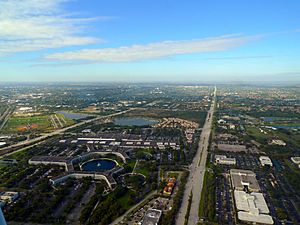
In the late 1960s, IBM decided to open a factory here. They secretly bought land west of the train tracks. Construction began in 1967. The big IBM complex opened in March 1970. It was designed to be self-sufficient. It had its own power station and water pumps.
By 1984, IBM was the biggest company employer in Palm Beach County. It had 8,500 workers in Boca Raton. This is where the IBM PC was created! This computer later led to other IBM products. In 1987, IBM moved its manufacturing elsewhere. The Boca Raton site became offices and labs. They worked on things like the OS/2 operating system and voice-recognition software.
IBM closed its main facility here in 1996. The site was sold and is now called the Boca Raton Innovation Campus (BRiC). A part of the old IBM complex was given to the school district. It became Don Estridge High Tech Middle School. It's named after Don Estridge, who led the team that made the IBM PC.
It's interesting to know that the office and conference table where Bill Gates signed his famous deal with IBM are still at the old complex. This deal was for Microsoft's MS-DOS operating system for the IBM PC.
City Growth
In 1991, a new outdoor shopping and dining area called Mizner Park was finished. It quickly became a popular spot in southern Palm Beach County. It looks like a Mediterranean "town center" with shops, restaurants, and homes. It's also home to the Boca Raton Museum of Art. In 2002, a new amphitheater was built for concerts and shows.
As the city grew, the Town Center at Boca Raton mall became a central point. This large mall was added to the city limits in 2004.
Boca Raton is known for its beautiful homes and fancy neighborhoods. In 2017, Forbes magazine said that Boca's Royal Palm Yacht and Country Club was one of the most exclusive gated communities in the U.S. Many new buildings and homes have been built recently.
In 2004, several nearby communities voted to join Boca Raton. This made the city's land area bigger.
Where is Boca Raton?
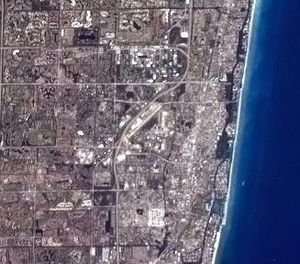
Boca Raton covers about 31.59 square miles (81.81 square kilometers). Most of this is land, with some water. It's a main city in the Miami metropolitan area. About 1 square mile of the city is on a barrier island called Deerfield Beach Island.
Like other cities in South Florida, Boca Raton has a high water table. This means you can't build basements here. However, plumbing and electrical systems are built underground. There are some higher spots in the city. For example, 4th Avenue is called "High Street." The highest point in this area is about 24 feet (7.3 m) above sea level.
Some small tunnels run under roads in Boca Raton. These roads are often built up a few feet. Several tunnels are under State Road A1A at Spanish River Park. They connect parking areas to the beach. A1A is already higher here because of sand dunes.
Neighborhoods
Pearl City is a neighborhood in Boca Raton. It's just north of downtown. It was first planned in 1915. It was a home for blue-collar African Americans. They worked at places like the Boca Raton Resort and on farms.
Weather in Boca Raton
Boca Raton has a tropical rainforest climate. This means it's warm and sunny for most of the year. From June to September, daily thunderstorms are common. It never gets frost here. The warm climate helps tropical trees and plants grow, like coconut palms.
In winter, high temperatures are usually between 75–83 degrees Fahrenheit (24–28 degrees Celsius). In summer, high temperatures are about 87–92 degrees Fahrenheit (31–33 degrees Celsius).
| Climate data for Boca Raton, Florida | |||||||||||||
|---|---|---|---|---|---|---|---|---|---|---|---|---|---|
| Month | Jan | Feb | Mar | Apr | May | Jun | Jul | Aug | Sep | Oct | Nov | Dec | Year |
| Mean daily maximum °F (°C) | 76 (24) |
77 (25) |
80 (27) |
83 (28) |
86 (30) |
88 (31) |
91 (33) |
91 (33) |
89 (32) |
86 (30) |
82 (28) |
78 (26) |
84 (29) |
| Mean daily minimum °F (°C) | 58 (14) |
60 (16) |
63 (17) |
67 (19) |
72 (22) |
75 (24) |
76 (24) |
75 (24) |
75 (24) |
71 (22) |
66 (19) |
61 (16) |
68 (20) |
| Average precipitation inches (mm) | 2.78 (71) |
2.85 (72) |
3.00 (76) |
3.40 (86) |
5.73 (146) |
7.31 (186) |
5.94 (151) |
6.91 (176) |
7.01 (178) |
5.73 (146) |
4.24 (108) |
2.46 (62) |
57.27 (1,455) |
| Source: The Weather Channel | |||||||||||||
Who Lives in Boca Raton?
Boca Raton and other parts of Palm Beach County have a large Jewish population. Some areas outside the city limits have many people from Brazil and other Latin American countries.
Boca Raton is known for its wealthy and well-educated community. Many expensive gated communities are found here.
Fun Things to Do and See
Festivals and Events
The Boca Raton Bowl is a college football game played at FAU Stadium. Teams from different college conferences play each year.
St. Mark Greek Orthodox Church in Boca Raton holds a popular Greek festival every January. Thousands of people attend this event.
The city also hosts the "[Festival of the Arts BOCA]" in the spring. In the fall, there's the Brazilian Beat Festival.
Mizner Park
Mizner Park is a popular spot in downtown Boca Raton. It has many stores, fashion boutiques, restaurants, and a movie theater. The Center for the Arts at Mizner Park is at the north end. It includes the Boca Raton Museum of Art and an amphitheater for shows. Nearby, Royal Palm Place offers more upscale shopping and dining.
Town Center Mall
Town Center at Boca Raton is a large, fancy shopping center. It's the biggest enclosed mall in Palm Beach County. It's also the third largest in South Florida.
The mall has been updated over the years. There are plans to add more shopping, dining, and entertainment options around it.
Beaches and Parks
Boca Raton has two miles of beautiful beaches. Popular spots include Red Reef Park and South Inlet Park.
Red Reef Park is home to the Gumbo Limbo Environmental Complex. This is a center for learning about the environment. It has sea tanks, a butterfly garden, and a boardwalk. You can also find an observation tower there. Florida Atlantic University runs a research facility at Gumbo Limbo. Students study coral reefs, sea turtles, and other ocean life.
Sugar Sand Park is another city park. It has the Children's Science Explorium, a fun science center for kids. Burt Aaronson South County Regional Park is in West Boca Raton. It has a golf course, a dog park, an amphitheater, a waterpark, and a nature center. Spanish River Park is a great place for picnics, swimming, and bird-watching along the Intracoastal Waterway.
Other Places to Visit
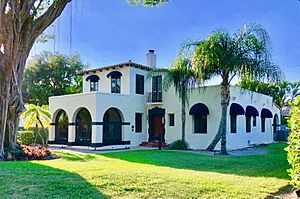
The Old Floresta Historic District has several old houses. They are listed on the National Register of Historic Places.
Boca Raton also has the Wick Theatre & Costume Museum.
Boca Raton's Economy
Many companies have their main offices in Boca Raton. Office Depot, a big supplier of office products, has its global headquarters here. The GEO Group and Friend Finder Networks are also based in the city.
Major Employers
Here are some of the top employers in Boca Raton:
- Boca Raton Regional Hospital
- Florida Atlantic University
- Office Depot (Headquarters)
- City of Boca Raton
- Boca Raton Resort and Club
- National Council on Compensation Insurance (NCCI)
- Johnson Controls / Tyco (Headquarters)
- Lynn University
- ADT Security Services (Headquarters)
- IBM
Learning in Boca Raton
Public Schools
Public schools in Boca Raton are managed by The School District of Palm Beach County. This is one of the largest school districts in the United States.
Boca Raton has several public high schools:
- Boca Raton Community High School serves the eastern part of the city.
- Spanish River Community High School serves the west-central part of the city.
- Olympic Heights Community High School and West Boca Raton Community High School serve areas just outside the city limits.
There are five public middle schools:
- Don Estridge High Tech Middle School is a special technology school. It's named after Don Estridge, who helped create the IBM Personal Computer.
- Boca Raton Community Middle School
- Eagles Landing Middle School
- Loggers' Run Community Middle School
- Omni Middle School
The area also has thirteen public elementary schools:
- Addison Mizner Elementary
- Blue Lake Elementary
- Boca Raton Elementary
- Calusa Elementary
- Coral Sunset Elementary
- Del Prado Elementary
- Hammock Pointe Elementary
- J.C. Mitchell Elementary
- Sandpiper Shores Elementary
- Sunrise Park Elementary
- Verde K-8
- Waters Edge Elementary
- Whispering Pines Elementary
Other School Options
Two other school options are on the Florida Atlantic University campus. They are the K–8 Alexander D. Henderson University School (ADHUS) and FAU High School (FAUHS). These schools are public and do not charge tuition. They are open to students from Palm Beach County or Broward County.
FAU High School is a program where students take college classes. They earn both high school and college credits at the same time. Students who finish all four years at FAU High School will have completed three years of university study.
Private Schools
Boca Raton has many private schools, including:
- Boca Raton Christian School
- Harid Conservatory
- Katz Hillel Day School
- Pine Crest School
- Saint Jude Catholic School and Parish
- Saint Andrew's School
- Saint John Paul II Academy
- Grandview Preparatory School
- Donna Klein Jewish Academy
- Boca Prep International School
- Saint Joan of Arc Catholic School and Church
- Katz Yeshiva High School of Boca Raton
- Spanish River Christian
- Saint Paul Lutheran School
- Advent Lutheran School
- Torah Academy of Boca Raton
- American Heritage School
Colleges and Universities
Florida Atlantic University (FAU) opened its first classes in Boca Raton in 1964. It is the largest university in Boca Raton, with over 29,000 students. FAU is part of the State University System of Florida.
Lynn University is another four-year school. Its Digital Media Arts College offers degrees in computer animation and graphic design.
Palm Beach State College has a campus next to Florida Atlantic University. It opened in 1983.
Everglades University also has its main campus in Boca Raton.
Libraries and News
The Boca Raton Public Library serves people living in the city. There are also county library branches nearby for those living outside the city limits. Library card holders can use any of the sixteen branches in the Palm Beach County Library System. They can also access many online resources.
The Sun-Sentinel newspaper provides local news for the area.
Getting Around Boca Raton
By Air
The Boca Raton Airport (BCT) is a general aviation airport. It's right next to Florida Atlantic University and Interstate 95. It's mostly used by private jets and charter planes.
Boca Raton is also served by three major commercial airports. These are Fort Lauderdale-Hollywood International Airport, Palm Beach International Airport, and Miami International Airport. You can get to Miami International Airport by car or by using Tri-Rail.
By Road
- State Road A1A runs north and south along the coast.
- U.S. Highway 1, also called "Federal Highway," goes through the city's downtown.
- U.S. Highway 441 (State Road 7) runs north and south west of the city.
- Interstate 95 cuts through the city from north to south. It has four exits for Boca Raton.
- Florida's Turnpike passes through areas just outside Boca Raton. It has one exit at Glades Road.
- Other important east-west roads include Glades Road, Palmetto Park Road, and Yamato Road.
- Other important north-south roads include Military Trail and Jog Road / Powerline Road.
By Rail
- The Tri-Rail commuter train system has a station in Boca Raton. It's on Yamato Road, near I-95.
- Freight trains from CSX Transportation and Florida East Coast Railway also serve the city.
- Brightline has a station next to the Boca Raton Public Library. It offers train service to Miami, Fort Lauderdale, West Palm Beach, Aventura, and Orlando.
By Bus
- PalmTran provides local bus service in the area.
By Water
Long ago, the area had a lagoon called "Boca Ratones Lagoon." It stretched for about 9 miles (14 km). This lagoon had three wide areas called "Lakes." Today, they are Lake Rogers, Lake Wyman, and Lake Boca Raton.
The lagoon was deepened in 1894–1895 to become part of the Florida East Coast Canal. This canal was later improved and renamed the Intracoastal Waterway. It's a busy route for boats.
Boca Raton has a clever way to reuse wastewater. They sell the treated water to golf courses for irrigation. This system, called IRIS, helps keep nutrients out of the ocean. This reduces the city's impact on problems like toxic algae blooms.
Images for kids
See also
 In Spanish: Boca Ratón para niños
In Spanish: Boca Ratón para niños


